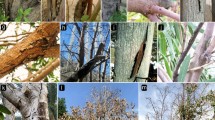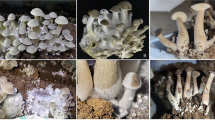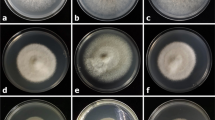Abstract
Cladobotryum species and strain diversity of isolates collected from cobweb symptomatic Agaricus bisporus or infected casing soil were investigated due to increased incidences of the disease in the South African mushroom industry. Samples were collected from mushroom farms located in Gauteng, the Western Cape and KwaZulu Natal Provinces of South Africa. Moreover, cobweb disease isolates from the USA and Ireland were included in the study as reference cultures. Isolates were characterised using culture and conidia morphology and were identified as Cladobotryum mycophilum. The isolates were characterised by rapid colony growth between 48 and 72 h on malt extract agar and potato dextrose agar, all but two isolates (GP-15 and KZN-2) produced the pink colour of aurofurasin. All isolates could infect A. bisporus fruiting bodies with varying degrees of aggressiveness. Isolates were sequenced for their ITS, and BLAST analysis showed highest similarity (99–100%) to several ITS sequences of Hypomyces odoratus/C. mycophilum for 35 of the isolates except for one from Ireland that was identified as H. rosellus/C. dendroides. Phylogenetic analysis of the isolates showed South African cobweb disease of mushrooms to be caused by a wide diversity of strains some of which may have originated from elsewhere in the world.


Similar content being viewed by others
References
Adie, B., Grogan, H., Archer, S., & Mills, P. (2006). Temporal and spatial dispersal of Cladobotryum conidia in the controlled environment of a mushroom growing room. Applied and Environmental Microbiology, 72, 7212–7217.
Back, C. G., Kim, Y. H., Jo W. S., Chung, H. & Jung, H, Y. (2010). Cobweb disease on Agaricus bisporus caused by Cladobotryum mycophilum in Korea. Journal of General Plant Pathology, 76, 232–235.
Back, C. G., Lee, C. Y., Seo, G. S., & Jung, H. C. (2012). Characterisation of species of Cladobotryum which cause cobweb disease of edible mushrooms grown in Korea. Mycobiology, 40(3), 189–194.
Becker, T. C. A., Chiuchetta, S. J. R., Baptista, F., & de Castro-Padro, M. A. A. (2003). Increase in mitotic recombination in diploid cells of Aspergillus nidulans in response to ethidium bromide. Genetics and Molecular Biology, 26(3), 381–385.
Booth, C. (1975). The present status of Fusarium taxonomy. Annual Review of Phytopathology, 13, 83–93.
Carrasco, J., Navarro, M. J., Santos, M., Diánez, F., & Gea, F. J. (2016). Incidence, identification and pathogenicity of Cladobotryum mycophilum, causal agent of cobweb disease on Agaricus bisporus mushroom crops in Spain. Annals of Applied Biology, 168(2), 214–224.
Carrasco, J., Navarro, M. J., & Gea, F. J. (2017a). Cobweb, a serious pathology in mushroom crops: A review. Spanish Journal of Agricultural Research, 15(2), e10R01.
Carrasco, J, Navarro, M. J., Santos, M. & Gea, F. J, (2017b). Effect of five fungicides with different modes of action on cobweb disease (Cladobotryum mycophilum) and mushroom yield. Annals of applied biology, https://doi.org/10.1111/aab.12352.
Chakwiya, A., Van der Linde, E. J., & Korsten, L. (2015). In vitro sensitivity testing of Cladobotryum mycophilum to carbendazim and prochloraz manganese. South African Journal of Science, Volume 111. https://doi.org/10.17159/sajs.2015/20140408.
Felsenstein, J. (1985). Phylogenies and the Comparative Method. The American Naturalist, 125(1), 1–15.
Fletcher, J. T., & Gaze, R. H. (2008). Mushroom pest and disease control – A colour handbook. London: Manson Publishing Ltd..
Gams, W., & Hoozeman, A. C. M. (1970). Cladobotryum-konidienformen von Hypomyces-Arten. Persoonia, 6, 95–110.
Gardes, M., & Bruns, T. D. (1993). ITS primers with enhanced specificity for basidiomycetes-application to the identification of mycorrhizae and rusts. Molecular Ecology, 2(2), 113–118.
Gea, F. J., Navarro, M. J., & Tello, J. C. (2005). Reduced sensitivity of the mushroom pathogen Verticillium fungicola to prochloraz-manganese in vitro. Mycological Research, 109, 741–745.
Gea, F. J., Navarro, M. J., & Suz, L. M. (2011). First report of Cladobotryum mycophilum causing cobweb on cultivated king oyster mushroom in Spain. Plant Disease, 95(8), 1030.
Gea, F. J., Carrasco, J., Suz, L. M., & Navarro, M. J. (2017). Characterization and pathogenicity of Cladobotryum mycophilum in Spanish Pleurotus eryngii mushroom crops and its sensitivity to fungicides. European Journal of Plant Pathology, 147(1), 129–139.
Grogan, H. M. (2006). Fungicide control of mushroom cobweb disease caused by Cladobotryum strains with different benzimidazole resistance profiles. Pest Management Science, 62, 153–161.
Grogan, H. M., & Gaze, R. H. (2000). Fungicide resistance among Cladobotryum spp. - causal agents of cobweb disease of the edible mushroom Agaricus bisporus. Mycological Research, 104(3), 357–364.
Jukes, T. H., & Kantor, C. R. (1969). Evolution of protein molecules. In H. N. Munro (Ed.), Mammalian protein metabolism (Vol. II, pp. 21–123). New York: Academic Press.
Katoh, K., & Toh, H. (2008). Recent developments in the MAFFT multiple sequence alignment program. Briefings in Bioinformatics, 9(4), 286–298.
Kimura, M. (1980). A simple method for estimating evolutionary rates of base substitutions through comparative studies of nucleotide sequences. Journal of Molecular Evolution, 16(2), 111–120.
Kumar, S., Stecher, G., & Tamura, K. (2016). MEGA7: Molecular evolutionary genetics analysis version 7.0 for bigger datasets. Molecular Biology and Evolution, 33, 1870–1874.
McKay, G. J., Egan, D., Morris, E., Scott, C., & Brown, A. E. (1998). Identification of benzimidazole resisitance in Cladobotryum dendroides using a PCR- based method. Mycological Research, 102, 671–676.
McKay, G. J., Egan, D., Morris, E., Scott, C., & Brown, A. E. (1999). Genetic and morphological characterization of Cladobotryum species causing cobweb disease of mushrooms. Applied and Environmental Microbiology, 65(2), 606–610.
Morgulis, A., Coulouris, G., Raytselis, Y., Madden, T. L., Agarwala, R., & Schäffer, A. A. (2008). Database indexing for production MegaBLAST searches. Bioinformatics, 24(16), 1757–1764.
Põldmaa, K. (2011). Tropical species of Cladobotryum and Hypomyces producing red pigments. Studies in Mycology, 68, 1–34.
Potočnik, I., Recanovick, E., Milijašević, S., Todorović, B., & Stepanović, M. (2008). Morphological and pathogenic characteristics of the fungus Cladobotryum dendroides, the causative agent of cobweb disease of the cultivated mushroom Agaricus bisporus in Serbia. Pesticide and Phytomedicine, 23, 175–181.
Potocnik, I., Vukojevic, J., Stajić, M., Rekanović, E., Milijasević, S., Todorović, B., & Stepanović, M. (2009). In vitro toxicity of selected fungicides from the groups of benzimidazoles and demethylation inhibitors to Cladobotryum dendroides and Agaricus bisporus. Journal of Environmental Science and Health B, 44, 364–370.
Richardson, R. (2010). SAMFA Chairman’s report. The Spawn Run, 1, 2–4.
Rogerson, C. T., & Samuels, G. J. (1993). Polyporicolous species of Hypomyces. Mycologia, 85(2), 231–276.
Rogerson, C. T., & Samuels, G. J. (1994). Agaricolous species of Hypomyces. Mycologia, 86(6), 839–866.
Tamm, H., & Põldmaa, K. (2013). Diversity, host associations, and phylogeography of temperate aurofusarin-producing Hypomyces/Cladobotryum including causal agents of cobweb disease of cultivated mushrooms. Fungal Biology, 117, 348–367.
White, T. J., Bruns, T., Lee, S., & Taylor, J. (1990). Amplification and direct sequencing of fungal ribosomal RNA genes for phylogenetics. In M. A. Innis, D. H. Gelfand, J. J. Sninsky, & T. J. White (Eds.), PCR protocols. A guide to methods and applications (pp. 315–322). San Diego: Academic Press.
Zuo, B., Lu, B. H., Liu, X. L., Wang, Y., Ma, G. L., & Gao, J. (2016). First report of Cladobotryum mycophilum causing cobweb on Ganoderma lucidum cultivated in Jilin province, China. Plant Disease, 100(6), 1239.
Funding
Funding for this research was provided by the South African Mushroom Association (SAMFA), Technology and Human Resources for Industry Programme (THRIP) and the University of Pretoria. Alinesi Chakwiya is a recipient of a postgraduate fellowship from SIDA through the Organisation for Women in Science for the Developing World (OWSD), formerly TWOWS.
Author information
Authors and Affiliations
Corresponding author
Ethics declarations
Conflict of interest
The authors declare that they have no conflict of interest.
Rights and permissions
About this article
Cite this article
Chakwiya, A., Van der Linde, E.J., Chidamba, L. et al. Diversity of Cladobotryum mycophilum isolates associated with cobweb disease of Agaricus bisporus in the south African mushroom industry. Eur J Plant Pathol 154, 767–776 (2019). https://doi.org/10.1007/s10658-019-01700-7
Accepted:
Published:
Issue Date:
DOI: https://doi.org/10.1007/s10658-019-01700-7




